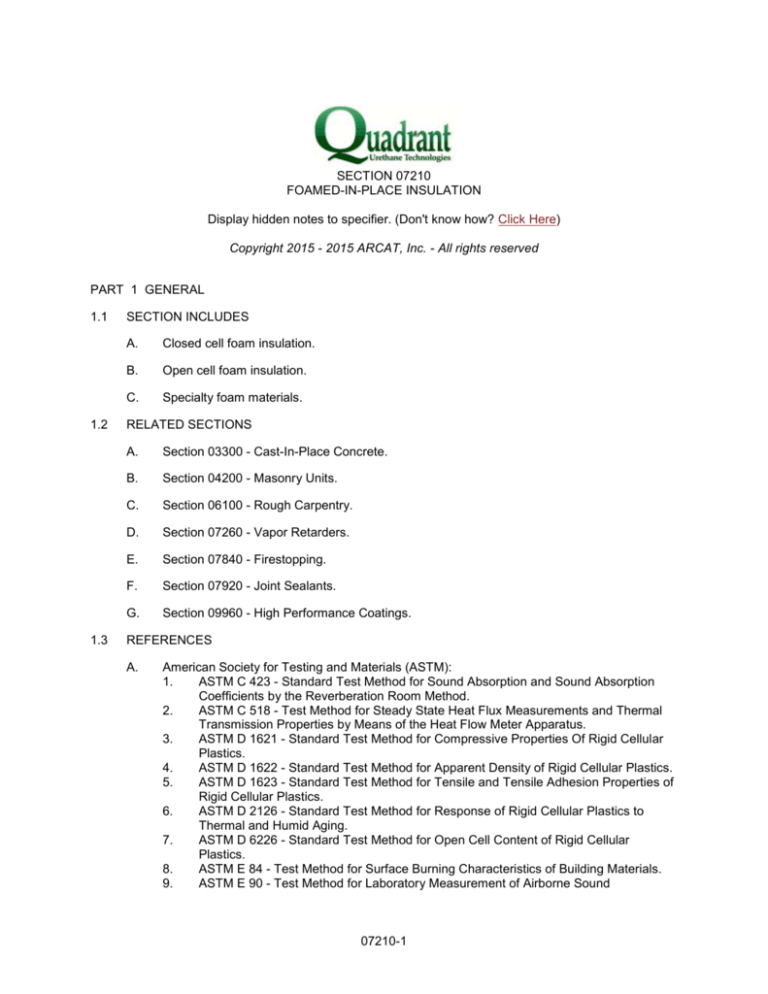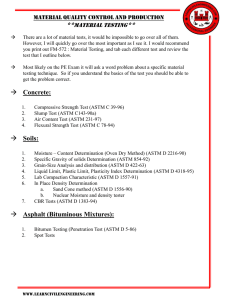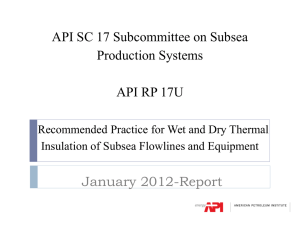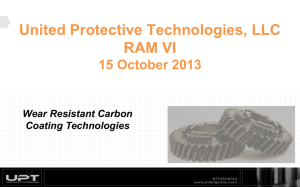
SECTION 07210
FOAMED-IN-PLACE INSULATION
Display hidden notes to specifier. (Don't know how? Click Here)
Copyright 2015 - 2015 ARCAT, Inc. - All rights reserved
PART 1 GENERAL
1.1
1.2
1.3
SECTION INCLUDES
A.
Closed cell foam insulation.
B.
Open cell foam insulation.
C.
Specialty foam materials.
RELATED SECTIONS
A.
Section 03300 - Cast-In-Place Concrete.
B.
Section 04200 - Masonry Units.
C.
Section 06100 - Rough Carpentry.
D.
Section 07260 - Vapor Retarders.
E.
Section 07840 - Firestopping.
F.
Section 07920 - Joint Sealants.
G.
Section 09960 - High Performance Coatings.
REFERENCES
A.
American Society for Testing and Materials (ASTM):
1.
ASTM C 423 - Standard Test Method for Sound Absorption and Sound Absorption
Coefficients by the Reverberation Room Method.
2.
ASTM C 518 - Test Method for Steady State Heat Flux Measurements and Thermal
Transmission Properties by Means of the Heat Flow Meter Apparatus.
3.
ASTM D 1621 - Standard Test Method for Compressive Properties Of Rigid Cellular
Plastics.
4.
ASTM D 1622 - Standard Test Method for Apparent Density of Rigid Cellular Plastics.
5.
ASTM D 1623 - Standard Test Method for Tensile and Tensile Adhesion Properties of
Rigid Cellular Plastics.
6.
ASTM D 2126 - Standard Test Method for Response of Rigid Cellular Plastics to
Thermal and Humid Aging.
7.
ASTM D 6226 - Standard Test Method for Open Cell Content of Rigid Cellular
Plastics.
8.
ASTM E 84 - Test Method for Surface Burning Characteristics of Building Materials.
9.
ASTM E 90 - Test Method for Laboratory Measurement of Airborne Sound
07210-1
10.
1.4
Transmission Loss of Building Partitions.
ASTM E 96 - Standard Test Method for Water Vapor Transmission of Materials.
SUBMITTALS
A.
Submit under provisions of Section 01300.
B.
Product Data: Manufacturer's data sheets on each product to be used, including:
1.
Preparation instructions and recommendations.
2.
Storage and handling requirements and recommendations.
3.
Product test reports performed by a qualified independent testing agency evidencing
compliance of insulation products with specified requirements including those for
thermal resistance, fire-test-response characteristics, water-vapor transmission, water
absorption, and other properties, based on comprehensive testing of current products.
4.
Installation methods. Indicate special procedures, substrate and perimeter conditions
requiring special treatment.
C.
LEED New Construction (NC v3) Documentation:
1.
EA Credit 1: Optimize Energy Performance.
2.
MR Credit 2: Construction Waste Management.
3.
MR Credit 4: Recycled Content.
4.
IEQ Credit 5: Indoor Chemical and Pollutant Source Control.
5.
IEQ Credit 7.1: Thermal Comfort.
D.
LEED for Homes Rating System Submittals:
1.
EA Credit 1.1: Performance of ENERGY STAR Homes (or EA 2-10 Pathway).
2.
EA Credit 2.1: Basic Insulation: Product data showing R-value for sprayed insulation.
3.
EA Credit 3: Air Infiltration.
4.
EA Credit 5.1 and 5.2: Heating and Cooling Distribution System.
5.
MR Credit 2.2: Environmentally Preferable Products: Product Data substantiating
sprayed insulation complies with CA practice for testing of VOC's from building
materials using small chambers.
6.
MR Credit 3.2: Construction Waste Reduction.
7.
EQ Credit 1: ENERGY STAR with Indoor Air Package (Pathway).
8.
EQ Credit 10: Garage Pollutant Protection.
E.
LEED for Schools Rating System Submittals:
1.
EA Credit Prerequisite 2: Minimum Energy Performance.
2.
EA Credit 1: Optimize Energy Performance.
3.
IEQ Credit 4: Low Emitting Materials: Product data showing compliance with
California DHS/EHLB/R174.
4.
IEQ Credit 7.1: Thermal Comfort - Design.
5.
IEQ Credit 9: Enhanced Acoustical Performance.
6.
IEQ Credit 10: Mold Prevention.
F.
NAHB National Green Building Standard (ICC-700-08) Submittals:
1.
Credit 607.1: Resource - Efficient Materials.
2.
Credit 701.4.5: Insulation and Air Sealing.
3.
Credit 702: Performance Path (Energy) or 703 Prescriptive Path.
4.
Credit 704.6.1: Performance Verification.
5.
Credit 704.6.2: Third Party Testing.
6.
Credit 704.6.2.1: Building Envelope Air Leakage.
7.
Credit 901.3: Garages - Air Barrier.
8.
Credit 901.11: Insulation - Emissions: Product Data confirming sprayed insulation
contains formaldehyde emission levels that comply with the requirements of CA/DHS
01350.
9.
Credit 902.11: Perimeter of Living Space Sealed.
07210-2
10.
11.
1.5
1.6
Credit 903.4: Conditioned Crawlspace is Sealed.
Credit 903.5: Building Materials - No Visible Mold.
G.
Collaborative for High Performance Schools (CHPS) Submittals:
1.
Credit LE 13.1: Innovation.
2.
Credit EE 1.0: Minimum Energy Performance.
3.
Credit EE 1.1: Superior Energy Performance.
4.
Credit ME 2.1: Construction Site Waste Management.
5.
Credit ME 4.1: Recycled Content: Product Data confirming the contribution of the
material to the weighted average recycled content value, such that the sum of all such
values meet the 10 percent or 20 percent threshold.
6.
Credit EQ 2.2: Low Emitting Materials: Product Data confirming sprayed meets the
CHPS Low Emitting Materials criteria Section 01350 - for use in a typical classroom
as described in a CA/DHS Standard Practice.
7.
Credit EQ 3.0: Minimum Acoustical Performance.
8.
Credit EQ 3.1: Improved Acoustical Performance.
9.
Credit EQ 4.0: ASHRAE 55, Thermal Comfort Code Compliance and Moisture
Control.
H.
Certifications:
1.
Submit manufacturer's certificate that products meet or exceed specified
requirements.
2.
Evaluation Report: Evidence of compliance of foam-plastic insulations with the
International Building Code (IBC), International Residential Code (IRC), or
International Energy Conservation Code (IECC).
3.
Installer's certificate showing the Quadrant Urethane Technologies installation
certification.
4.
Submit installer qualifications.
QUALITY ASSURANCE
A.
Single Source Responsibility: Provide products from a single source from one manufacturer.
B.
Manufacturer Qualifications:
1.
Product shall be manufactured at ISO 9001:2008 certified facility and meeting ICC
Code and IAPMO Standards.
2.
Company with minimum three years' experience manufacturing specified products.
C.
Installer Qualifications:
1.
Utilize an installer having demonstrated experience on projects of similar size and
complexity.
2.
Utilize a Quadrant Urethane Technologies Licensed Dealer (applicator) who has been
trained and certified by Quadrant Urethane Technologies.
D.
Coordinate mechanical ventilation and fresh air supply with Mechanical sections and
ASHRAE Guidelines for optimum indoor air quality.
E.
Mock-Up: Provide a mock-up for evaluation of surface preparation techniques and
application workmanship.
1.
Finish areas designated by Architect.
2.
Do not proceed with remaining work until workmanship is approved by Architect.
3.
Rework mock-up area as required to produce acceptable work.
PRE-INSTALLATION MEETINGS
A.
Convene minimum two weeks prior to starting work of this section.
07210-3
1.7
1.8
REGULATORY REQUIREMENTS
A.
Conform to applicable code requirements for flame and smoke ratings and noncombustibility as applicable.
B.
Fire-Test-Response Characteristics: Provide materials specified as determined by testing
identical products per test method indicated below by a testing and inspecting agency
acceptable to authorities having jurisdiction. Identify materials with appropriate markings of
applicable testing and inspecting agency.
1.
Surface-Burning Characteristics: ASTM E84.
C.
Provide independent third party testing and labeling on product for fire hazard classification.
Provide testing agency approval recognized by local Authority Having Jurisdiction (AHJ).
ENVIRONMENTAL REQUIREMENTS
A.
1.9
Toxicity/Hazardous Materials:
1.
Products containing urea-formaldehyde shall not be permitted.
2.
Products that contain no PBDEs.
3.
Products and equipment requiring or using CFCs, HCFCs, or HFCs during the
manufacturing or application process will not be permitted
4.
Products that are "Low-emitting material".
DELIVERY, STORAGE, AND HANDLING
A.
Comply with manufacturers written instructions for storage, handling and protection prior to
and during installation.
B.
Store both components in a temperature controlled area between 65 degree F (18 degree C)
and 85 degree F (29 degree C). Consult manufacturer's written instructions. Do not allow
product to freeze.
C.
Do not expose to sunlight, except to extent necessary for period of installation and
concealment.
D.
Use only those components that are supplied by the manufacturer for the specified product.
1.10 PROJECT CONDITIONS
A.
Maintain environmental conditions (temperature, humidity, and ventilation) within limits
recommended by manufacturer for optimum results. Do not install products under
environmental conditions outside manufacturer's recommended limits.
1.11 SEQUENCING
A.
Ensure that products of this section are supplied to affected trades in time to prevent
interruption of construction progress.
1.12 WARRANTY
A.
Manufacturer's Warranty: Provide manufacturer's standard limited lifetime warranty.
PART 2 PRODUCTS
2.1
MANUFACTURERS
A.
Acceptable Manufacturer: Quadrant Urethane Technologies, which is located at: 200
Industrial Blvd.; McKinney, TX 75069; Toll Free Tel: 866-547-7163;
07210-4
Email:info@QuadFoam.com; Web:www.quadfoam.com
2.2
B.
Substitutions: Not permitted.
C.
Requests for substitutions will be considered in accordance with provisions of Section
01600.
CLOSED CELL FOAM INSULATION
A.
Closed Cell Foam Insulation: QuadFoam 2.0 as manufactured by Quadrant Urethane
Technologies.
1.
Vapor Barrier: The insulation shall have vapor permeance of 1.0 perm (5.7x10-11
kg/(Pa-s-m2)) or less when applied at a minimum thickness of 1.5 inches (38 mm) and
tested in accordance with ASTM E96; and qualifies as a Class II vapor retarder under
the IBC and IRC. (ICC-ES Evaluation Report ESR-3459).
2.
Air Permeability: The insulation, at a minimum thickness of 1.0 inch (25.4 mm), shall
be considered air-impermeable insulation in accordance with 2012 IRC Section
R806.5 and 2009 IRC Section R806.4, based on testing in accordance with ASTM
E283.
3.
Closed Cell 2.0 lb Insulation System Material Characteristics: (ICC-ES Evaluation
Report ESR-3459).
a.
Density (ASTM D-1622): 2.0 pcf
b.
Closed Cell Content (ASTM D-6226): > 90%
c.
Tensile Strength (ASTM D-1623): 45 psi
d.
R-value at 1 inch (ASTM C-518): 6.5
e.
Moisture Vapor Transmission (ASTM E-96): 1.0 perm @ 1.5 in
f.
Air Permeance (ASTM E-96): 0.0019 cfm/ft2
g.
Dimensional Stability (ASTM D-2126): < 15%
h.
Compressive Strength (ASTM D-1621): 22 psi
i.
Flammability (ASTM E-84 at 2 inches):
1)
Flame Spread: 10.
2)
Smoke Developed: 450.
4.
Product: QuadFoam NatureSeal 2.0 as manufactured by Quadrant Urethane
Technologies.
5.
Product: QuadFoam 2.0 w/sw/ha as manufactured by Quadrant Urethane
Technologies.
B.
Application Without a Prescriptive Ignition Barrier:
1.
QuadFoam 2.0: The attic or crawl space and attic floor area insulation may be left
exposed without a prescriptive ignition barrier. The attic or crawl space and attic floor
area must be separated from the interior of the building by an approved 15-minute
thermal barrier. (Refer to ICC-ES Evaluation Report ESR-3459 for maximum
thickness for applications).
C.
Application With a Prescriptive Thermal Barrier:
1.
Open Cell Foam materials shall be separated from the interior of the building by an
approved thermal barrier complying with, and installed in accordance with, IBC
Section 2603.4 or IRC Section R316.4, as applicable, except where insulation is in an
attic or crawl space. Thicknesses up to 7-1/2 inches (191 mm) for wall cavities and
11-1/2 inches (292 mm) for ceiling cavities are recognized based on room corner
testing in accordance with NFPA 286, when covered with minimum 1/2 inch thick (13
mm) gypsum wallboard or an equivalent thermal barrier complying with, and installed
in accordance with, the applicable code.
2.
QuadFoam 2.0 has been tested and approved in accordance to AC 377 (NFPA)
Appendix X with the following thermal barriers. (Refer to ICC-ES Evaluation Report
ESR-3458 for maximum thickness for applications):
a.
Thermal Barrier: QuadCoat TB Intumescent Coating System: 18 mils (0.46 mm)
07210-5
b.
c.
2.3
WFT total system thickness. The QuadCoat TB intumescent coating system
consists of QuadCoat ICP Primer and Quad Coat TB intumescent Top Coat
coatings, manufactured by TPR2Corporation.
Thermal Barrier: TPR2Fireshell TB Intumescent Coating System: 18 mils (0.46
mm) WFT total system thickness. The Fireshell TB intumescent coating system
consists of Fireshell ICP Primer and Fireshell TB Top Coat coatings,
manufactured by TPR2Corporation.
Thermal Barrier: DC315 Intumescent Coatings: 18 mils (0.46 mm) WFT total
system thickness. The DC315 intumescent coatings system consists of DC315
Primer and DC315 Top Coat are intumescent single-component, water-based
coatings, manufactured by International Fireproof Technology, Inc.
OPEN CELL FOAM INSULATION
A.
Open Cell Foam Insulation: QuadFoam 500 as manufactured by Quadrant Urethane
Technologies.
1.
QuadFoam 500 spray-foam insulation qualifies as an air-impermeable insulation at a
minimum thickness of 3.5 inches (89 mm) and, when installed in accordance with
ICC-ES AC 377, may be used to insulate unvented attics in accordance with IRC
Section R806.4.
2.
Open Cell 0.5 lb (8 kg/m3) Insulation System Material Characteristics:
a.
Density (ASTM D-1622): 0.5 pcf (8 kg/m3).
b.
Open Cell Content (ASTM D-6226): > 97.65%.
c.
Tensile Strength (ASTM D-1623): 5.0 psi.
d.
R-value at 1 inch (ASTM C-518): 3.6
e.
Moisture Permeability (ASTM E-96): 9.8 perm/inch @ 3-1/2 inches (89 mm)
thickness.
f.
Dimensional Stability (ASTM D-2126): < 15%.
g.
Sound Transmission Coefficient (ASTM C-423): 50 (STC).
h.
Noise Reduction Coefficient (ASTM C-423): 0.7.
i.
Compressive Strength - Parallel (ASTM D-1621): .95 psi.
j.
Flammability (ASTM E-84 at 2 inches):
1)
Flame Spread: 10.
2)
Smoke Developed: 250.
B.
Open Cell Foam Insulation: QuadFoam NatureSeal 500 as manufactured by Quadrant
Urethane Technologies.
1.
QuadFoam 500 NatureSeal is Class 1 rated and meets AC 377 Appendix X
requirements without an Ignition Barrier Coating.
2.
Open Cell 0.5 lb (8 kg/m3) Insulation System Material Characteristics:
a.
Density (ASTM D-1622): 0.5 pcf (8 kg/m3).
b.
Open Cell Content (ASTM D-1940): > 95%.
c.
Tensile Strength (ASTM D-1623): 5.1 psi.
d.
R-value at 1 inch (ASTM C-518): 3.7.
e.
Dimensional Stability (ASTM D-2126): < 15%.
f.
Sound Transmission Coefficient (ASTM C-423): 48 (STC).
g.
Compressive Strength - Parallel (ASTM D-1621): 1.1 psi.
h.
Flammability (ASTM E-84 at 2 inches):
1)
Flame Spread: 0.
2)
Smoke Developed: 300.
C.
Application With a Prescriptive Thermal Barrier:
1.
Open Cell Foam materials shall be separated from the interior of the building by an
approved thermal barrier complying with, and installed in accordance with, IBC
Section 2603.4 or IRC Section R316.4, as applicable, except where insulation is in an
attic or crawl space. Thicknesses up to 7-1/2 inches (191 mm) for wall cavities and
07210-6
2.
3.
4.
D.
2.4
11-1/2 inches (292 mm) for ceiling cavities are recognized based on room corner
testing in accordance with NFPA 286, when covered with minimum 1/2 inch thick (13
mm) gypsum wallboard or an equivalent thermal barrier complying with, and installed
in accordance with, the applicable code.
Thermal Barrier: QuadCoat TB Intumescent Coating System: 9 mils (0.23 mm) WFT
primer and 15 mils (0.38 mm) WFT topcoat. The QuadCoat TB intumescent coating
system consists of QuadCoat ICP Primer and Quad Coat TB intumescent Top Coat
coatings, manufactured by TPR2Corporation.
Thermal Barrier: TPR2Fireshell TB Intumescent Coating System: 9 mils (0.23 mm)
WFT primer and 15 mils (0.38 mm) WFT topcoat. The Fireshell TB intumescent
coating system consists of Fireshell ICP Primer and Fireshell TB Top Coat coatings,
manufactured by TPR2Corporation.
Thermal Barrier: DC315 Intumescent Coatings: 4 mils (0.10 mm) WFT primer and 16
mils (0.41 mm) WFT topcoat. The DC315 intumescent coatings system consists of
DC315 Primer and DC315 Top Coat are intumescent single-component, water-based
coatings, manufactured by International Fireproof Technology, Inc.
Application With a Prescriptive Ignition Barrier:
1.
QuadFoam 500 has been tested and approved in accordance to AC 377 (NFPA)
Appendix X with the following ignition barriers. (Refer to ICC-ES Evaluation Report
ESR-3458 for maximum thickness for applications):
a.
Ignition Barrier: 4 mils (0.10 mm) WFT. Quadcoat IB Intumescent Coating:
Quadcoat IB intumescent coating system consists of a single-component,
water-based coating, manufactured by TPR2Corporation.
b.
Ignition Barrier: 4 mils (0.10 mm) WFT. TPR2Fireshell IB Intumescent Coating:
TPR2Fireshell IB intumescent coating system consists of a single-component,
water-based coating, manufactured by TPR2Corporation.
c.
Ignition Barrier: DC315 Intumescent Coatings: 4 mils (0.10 mm) WFT topcoat.
The DC315 intumescent coatings system consists of DC315 Top Coat which is
a intumescent single-component, water-based coating, manufactured by
International Fireproof Technology, Inc.
SPECIALTY FOAM MATERlALS
A.
Product: QuadFoam RetroSeal as manufactured by Quadrant Urethane Technologies.
B.
Product: BioSeal 700 as manufactured by Quadrant Urethane Technologies.
PART 3 EXECUTION
3.1
3.2
EXAMINATION
A.
Do not begin installation until substrates have been properly prepared.
B.
If substrate preparation is the responsibility of another installer, notify Architect of
unsatisfactory preparation before proceeding.
PREPARATION
A.
Do not proceed with installation until substrates have been properly prepared and deviations
from manufacturer's recommended tolerances are corrected. Commencement of installation
constitutes acceptance of conditions.
B.
Prepare substrates using the methods recommended by the manufacturer for achieving the
best result for the substrate under the project conditions.
1.
Review placement area to determine final location will not be within 3 inches (76 mm)
of any heat source where the temperature will exceed 180 degrees F (82 degrees C)
07210-7
2.
3.
4.
5.
C.
3.3
3.4
3.6
If preparation is the responsibility of another installer, notify Architect in writing of deviations
from manufacturer's recommended installation tolerances and conditions.
APPLICATION
A.
Apply insulation in accordance with manufacturer's written application instructions. Apply
insulation to a uniform thickness without voids.
B.
Apply to minimum cured thickness as indicated on the Drawings or as scheduled at the end
of this Section.
C.
Apply insulation to fill voids around doors and windows. Apply insulation to fill voids around
accessible service and equipment penetrations.
D.
Apply insulation to seal voids at truss ends to prevent wind scouring of ceiling insulation.
E.
Apply insulation to seal plumbing stacks, electrical wiring and other penetrations into attic to
control air leakage.
F.
Apply insulation to fill voids around bathtubs to point of accessibility.
G.
Water-Piping Coordination: If water piping is located within insulated exterior walls,
coordinate location of piping to ensure that it is placed on warm side of insulation and
insulation encapsulates piping.
H.
Apply insulation in unvented roof spaces and cathedral ceiling areas.
I.
Where building is designed to meet the specific airtightness standards apply insulation as
recommended by manufacturer to provide airtight construction. Apply transition membranes
and sealant to joints between air barrier components as specified in Division 7.
FIELD QUALITY CONTROL
A.
3.5
per ASTM C411 or in accordance with authorities having jurisdiction.
Mask and protect adjacent surfaces from overspray or damage.
Remove foreign materials, dirt, grease, oil, paint, laitance, efflorescence, and other
substances that will affect application.
Comply with manufacturer's written installation instructions for preparing cavities
indicated to receive insulation to be free of any foreign material that will impede
application.
Verify that other work on and within spaces to be insulated is complete prior to
application.
Inspect application for insulation thickness and density.
PROTECTION
A.
Do not permit subsequent work to disturb applied insulation.
B.
Protect installed insulation from damage due to harmful weather exposures, physical abuse,
and other causes. Provide temporary coverings where insulation is subject to abuse.
C.
Touch-up, repair or replace damaged products before Substantial Completion.
CONSTRUCTION WASTE MANAGEMENT
A.
Plan and coordinate the insulation work to minimize the generation of offcuts and waste.
Reuse insulation scraps to the maximum extent feasible.
07210-8
B.
3.7
Separate and recycle waste materials in accordance with the Waste Management Plan and
to the extent economically feasible.
SCHEDULES
A.
For the following locations, apply the average cured thickness indicated.
1.
Interior or exterior surface of basement walls: ______ inches.
2.
Insulation around main drain: ______ inches.
3.
Garage ceiling between joists and over air ducts: ______ inches.
4.
Insulation within interior ceilings: _____ inches.
5.
Insulation within interior walls: ______ inches.
6.
Cathedral ceilings: _____ inches.
7.
Attic and roof spaces: _____ inches.
8.
Voids in overhangs such as bay windows and cantilevered floors: _____ inches.
9.
Exterior above grade walls: _____ inches.
10.
Floor headers: _____ inches.
END OF SECTION
07210-9








